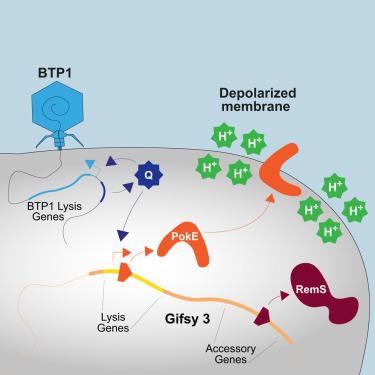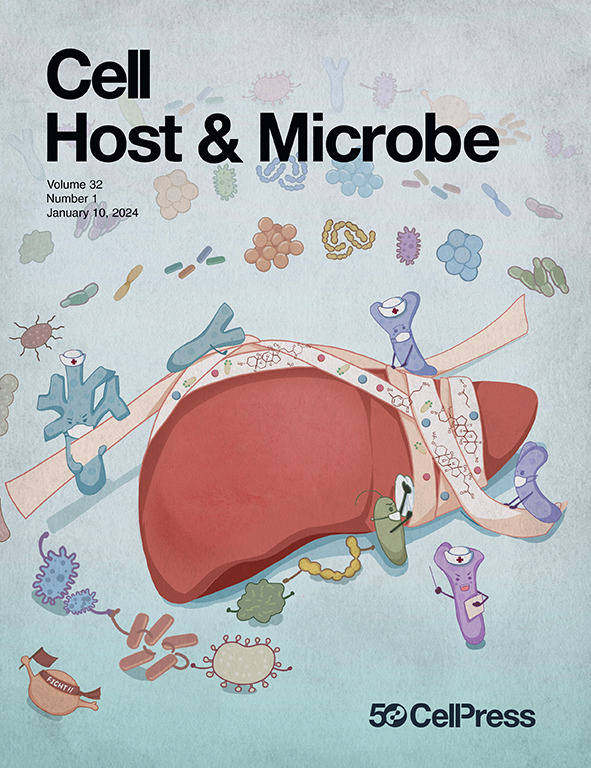A prophage intercepts pathogenic activity of infecting phage for defense
IF 18.7
1区 医学
Q1 MICROBIOLOGY
引用次数: 0
Abstract
Bacteria counter bacteriophage threats using diverse anti-phage systems often encoded on prophages within hotspots for accessory genes. These prophages must ensure that encoded defense systems do not inhibit their spread. Here, we discover two anti-phage defense elements, RemS and PokE, encoded within the Gifsy-3 prophage of Salmonella enterica Typhimurium 14028 that restrict phage infection without affecting the lytic cycle of Gifsy-3. RemS, an ATPase, is expressed from a hotspot for accessory genes in lambdoid phages. PokE is a small membrane-depolarizing protein/peptide encoded within the Gifsy-3 lysis cassette. During infection by phage BTP1, pokE transcription is specifically driven by the Q antiterminator of BTP1, as the infecting phage prepares to express its lysis genes. PokE then disrupts the BTP1 lytic cycle through abortive infection. Altogether, this work uncovers how a prophage repurposes an essential feature of phage lytic cycles to both detect and respond to a phage-specific essential pathogenic activity.

原噬菌体阻断被感染噬菌体的致病活性,起到防御作用
细菌利用不同的抗噬菌体系统对抗噬菌体的威胁,这些系统通常编码在辅助基因热点内的前噬菌体上。这些噬菌体必须确保编码防御系统不会抑制它们的传播。本研究发现,在大肠沙门氏菌伤寒沙门氏菌14028的Gifsy-3原噬菌体中编码了两个抗噬菌体防御元件RemS和PokE,它们在不影响Gifsy-3裂解周期的情况下限制了噬菌体感染。RemS是一种atp酶,在羔羊样噬菌体中从辅助基因的热点表达。PokE是一种小的膜去极化蛋白/肽,编码在Gifsy-3裂解盒中。在噬菌体BTP1感染期间,当感染噬菌体准备表达其裂解基因时,BTP1的Q抗菌剂特异性地驱动pokE转录。然后,PokE通过流产感染破坏BTP1的裂解周期。总之,这项工作揭示了噬菌体如何重新利用噬菌体裂解周期的基本特征来检测和响应噬菌体特异性的基本致病活性。
本文章由计算机程序翻译,如有差异,请以英文原文为准。
求助全文
约1分钟内获得全文
求助全文
来源期刊

Cell host & microbe
生物-微生物学
CiteScore
45.10
自引率
1.70%
发文量
201
审稿时长
4-8 weeks
期刊介绍:
Cell Host & Microbe is a scientific journal that was launched in March 2007. The journal aims to provide a platform for scientists to exchange ideas and concepts related to the study of microbes and their interaction with host organisms at a molecular, cellular, and immune level. It publishes novel findings on a wide range of microorganisms including bacteria, fungi, parasites, and viruses. The journal focuses on the interface between the microbe and its host, whether the host is a vertebrate, invertebrate, or plant, and whether the microbe is pathogenic, non-pathogenic, or commensal. The integrated study of microbes and their interactions with each other, their host, and the cellular environment they inhabit is a unifying theme of the journal. The published work in Cell Host & Microbe is expected to be of exceptional significance within its field and also of interest to researchers in other areas. In addition to primary research articles, the journal features expert analysis, commentary, and reviews on current topics of interest in the field.
 求助内容:
求助内容: 应助结果提醒方式:
应助结果提醒方式:


